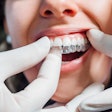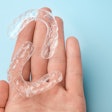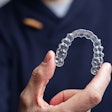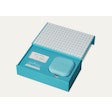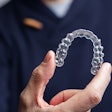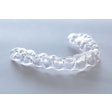Researchers from the West Virginia University (WVU) School of Dentistry are testing clear plastic dental aligners made with “shape memory” material, offering a potential alternative to metal braces, according to a university press release.
Furthermore, the thermoplastic used in this technology aims to offer a more adaptable fit and improve tooth repositioning, according to the release dated June 9.
“Thermoplastic aligners exhibit better grab and contact with the teeth and, therefore, can achieve higher efficacy in moving teeth than conventional aligners,” Egon Mamboleo, a graduate teaching assistant at the university, said in the release.
With funding from endowments established by orthodontic alumni and supporters of the university, researchers at WVU purchased 3D printers from Graphy, the Korea-based company that developed the thermoplastic aligner technology.
Dr. Peter Ngan, professor and chair of the department of orthodontics, is leading the research in collaboration with the WVU Benjamin M. Statler College of Engineering and Mineral Resources. Mechanical engineering professor Sam Mukdadi and his students are running various assessments to better understand the technology, according to the release.
Mamboleo simulated the biomechanical behavior of the aligners, analyzing how they affect teeth, periodontal ligaments, and surrounding bone. The process starts by scanning a patient’s mouth and creating a mold, but instead of outsourcing its production, aligners can be made onsite using Graphy’s printer.
 WVU researchers are testing technology that allows orthodontists to print patients’ dental aligners in their offices using a soft plastic with “memory” that helps the aligners hold their shape.WVU Photo/Davidson Chan.
WVU researchers are testing technology that allows orthodontists to print patients’ dental aligners in their offices using a soft plastic with “memory” that helps the aligners hold their shape.WVU Photo/Davidson Chan.
Some advantages include the softness of the thermoplastic, which makes it more compatible with tooth attachments and allows for layering that allows teeth to be repositioned more efficiently. When placed in hot water, the material softens and shrinks, making it easier to insert. Once in the mouth, body heat activates the aligner, returning it to its original shape to guide tooth movement, according to the release.
Ngan expects about half of orthodontic patients to use this type of aligner soon.
“These are suitable for all ages, so it’s the patient’s choice,” Ngan said. “When our residents and graduate students go into practice, they will be using this in their offices.”









